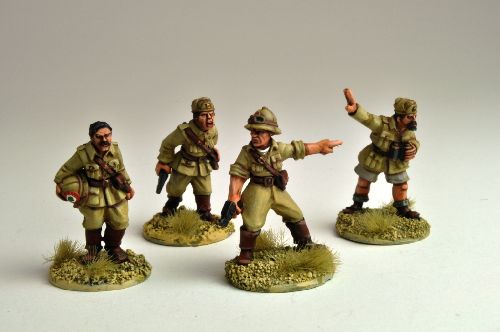Starting an Italian Army for Bolt Action
 By Kreighton Long
By Kreighton Long
With my Bolt Action Romanian army built and bloodied on the table, it’s time, once again, to look forward to a new project. Scrolling through my mental list of armies I aspire to paint and field I felt temporarily at a loss. While discussing my dilemma with a friend over a mid-war game of Bolt Action, he suggested I try something in the early-war period, so as to pair against his own early-war armies.
The suggestion was well received and we spent a good portion of the remainder of the game discussing my options. A combination of desiring to get the most mileage out of my next project and to build a less common army brought me to the stoop of the Italian Army.
The recent releases of Warlord’s Bolt Action: Campaign Italy: Soft Underbelly and plastic Italian Army opened the door and ushered me inside. As all my terrain is themed around European battlefields I decided to focus my research on the Italian participation in European campaigns and battles. Some quick online research into the campaigns fought by the Italian Army in Europe gave me some quality gaming options to consider including campaigns in Southern France, Greece, and Russia.
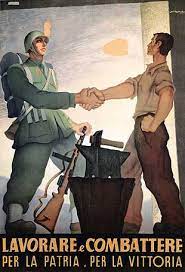
The Royal Italian Army, or Regio Esercito, joined World War Two on the side of Germany ten months after the opening of hostilities. With the Regio Esercito ill-prepared for a major war with the European democracies, the Italian government (read: Prime Minister Benito Mussolini) was hesitant to commit until France was on the verge of defeat and the British military overwhelmed by the seemingly unstoppable German juggernaut. Ten days after declaring war on France, Italy launched a campaign into the France’s western Alps and Mediterranean coast. The courage of the Italian soldier did little to compensate for poor planning and organization and Italian casualties dwarfed those of the French.
In October the Italians began their ill-fated invasion of Greece. By November the Greeks drove the Italians back across the border and a stalemate ensued broken only by the intervention of Germany in April 1941. Throughout the campaign, the Italian soldier fought commendably but again was let down by poor preparation and army-wide low morale resulting from failures throughout the invasion.
The Italians contributed 62,000 men to Operation Barbarossa in the form of the “Corpo Spedzione Italiane in Russia” (CSIR). The CSIR was sent to Ukraine in July 1941 and created a favorable first impression among their German allies following a string of successful encounters with Soviet forces. In the spring of 1942, an additional seven divisions reinforced the CSIR and the corps was upgraded to the 8th Army.
By August 1942 the Italian 8th Army had advanced to the Don River as part of Army Group B, which included Italians, Germans, Romanians, and Hungarians, and dug in north-west of the city of Stalingrad. As the Italians and Romanians were comparatively weaker than their German allies, they were the victims of the Soviet counterattacks north and south of Stalingrad during Operation Uranus.
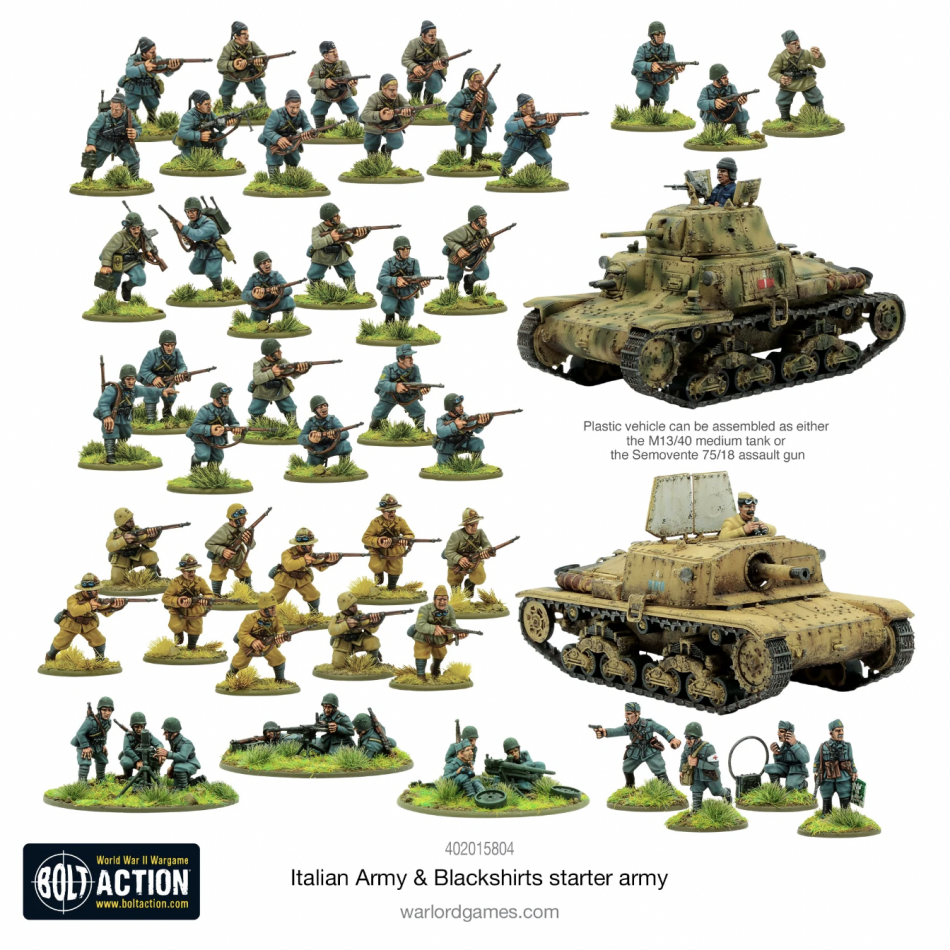
The Italian losses during Operation Uranus totaled approximately 115,000 personnel, of which 85,000 were killed or missing, from a total of 229,000. The loss of 1,200 of 1,340 artillery pieces and 18,200 of 22,000 vehicles were irreplaceable. The destruction of the Italian 8th Army brought an end to significant Italian participation on the Eastern Front — outside some occupation duties behind the lines.
Skipping ahead some, the Regio Esercito, would once again fight pitched battles in Europe during the Allied invasion of Sicily and Europe. Warlords’ Bolt Action: Campaign Italy: Soft Underbelly does a superb job of covering the campaigns until Italy’s capitulation, transition to Allied nation, and simultaneous civil war. Troy covers the new campaign book here if you’d like to see how much that book has to offer.
The variety of regions, climates, and adversaries the Regio Esercito fought in provides ample opportunities to get some serious mileage out of the investment. A Bolt Action Italian army could face off against early-war French, Greek, and Soviet forces not to mention a litany of partisans in parts of Europe the Italian army helped occupy. For mid-war action, an Italian player can face off against British or American forces during the invasion of Italy.
After Italy’s capitulation, an Italian player can see themselves play against German lists and even other Italian players as some Italian units fought with the German-backed government in northern Italy while others joined the Allies to liberate their country from the once German ally turned occupier. Similarly, the Italians fought in mountains, plains, towns, and cities in both the sun, mud, and snow. And this is without getting into the desert campaigns of North Africa!
With the cost-benefit analysis complete I decided to commit to starting an Italian army. The next question was what type of troops to theme my army around. The Regio Esercito has a variety of troop types to theme a Bolt Action army around — and Bolt Action has rules for all of them. First, you have the “regular guy” soldier. A common troop type for all theaters and periods of the war. Nothing flashy with these guys. Next, you have the Blackshirts, more formally known as the Milizia Volontaria per la Sicurezza Nazionale (Voluntary Militia for National Security), or MVSN for short.
These were Fascist Party paramilitary formations akin to the German Waffen SS. At 28mm scale Blackshirts are mostly unrecognizable from the regular army Soldatos. Next is the Paracadutisti (paratroopers). Like paratroopers from the other major powers these troops were considered elite and played as such. If you like painting camouflage this is the troop type for you. Next is the Bersaglieri (elite light infantry). Identified by a large black capercaillie feather worn on the left side of their headgear, these troops were held in the highest regard by their German allies.
The Alpini (mountain) troops’ trademark black feather on the right side of their headgear sets them apart aesthetically from other Italian options. Guastatori (assault engineers) were the hardest-hitting infantry the Italians fielded. Like assault engineers in other armies, the Guastatori wield heavy weapons such as flamethrowers and explosives to root out entrenched enemies.

I decided to start with a platoon of the humble “regular guy” infantry. Their presence on every battlefield and theater the Italians saw gives me options for fielding them against most opponents on any table while remaining true to historical accuracy. Add in a few standard support weapons and teams plus an Italian vehicle or two and I’ll be able to field a decent, admittedly plain, Italian army.
After wrapping up a “regular guy” list I hope to pivot to something more flavorful. As a glutton for painting-related punishment, I foresee myself heading in the direction of Paracadutisti with their eye-crossing camouflage. As I’ve learned with my Waffen SS army, painting camouflage is miserable but the finished products are truly beautiful to see on the table. I suspect the experience will replicate itself with a Paracadutisti army.
Lucky for anyone interested in starting or expanding an Italian army there are no shortages of manufacturers to choose from. Below are the first few I came across.
Perry Miniatures has a range of metal Italian models. Some are ready to take the fight to the enemy in Europe while others are sculpted with sun hats and shorts that are more appropriate for the African theater. Vehicles, guns, and support weapons also available.
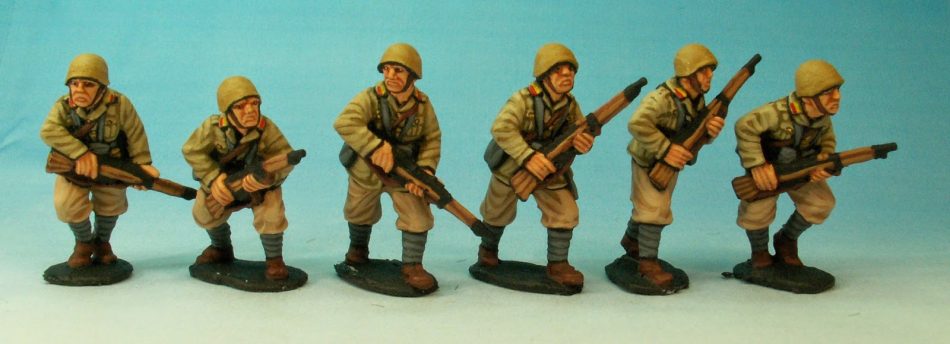
Warlord Games has a range of metal and plastic Italians. The range includes models for regular army, Paracadutisti (paratroopers), Bersaglieri (elite light infantry), and even a box of Guastatori (assault engineers). Vehicles, guns, and support weapons also available.
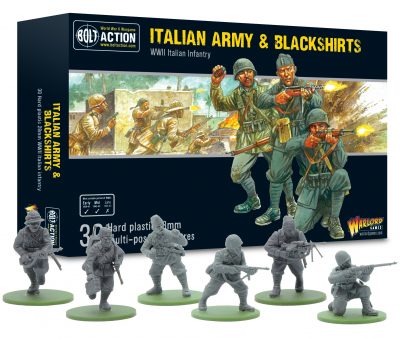
Gaddis Gaming has a range of metal Italians including regular army, Alpini (mountain), Bersaglieri, and North Africa packs. Infantry and support weapons available.
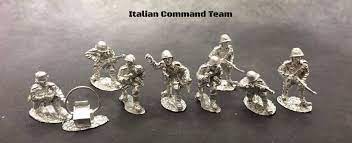
Wargames Atlantic recently released a box of plastic Italian infantry with head options to model your force in standard helmets, pith helmets for North Africa, Alpine hats for Alpini troops, Bustina (soft caps), and separate feathers to create Bersalieri. Only infantry models at this time.
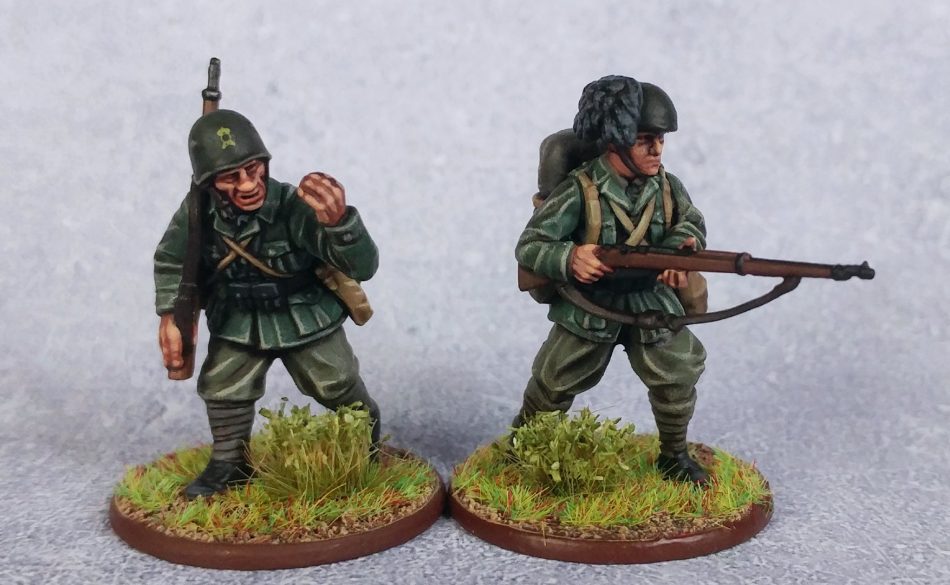
Artizan Designs carries a few packs of metal Italians sculpted to fit in North Africa. The options are limited to the standard array of commanders, riflemen, SMGs, and LMGs.
